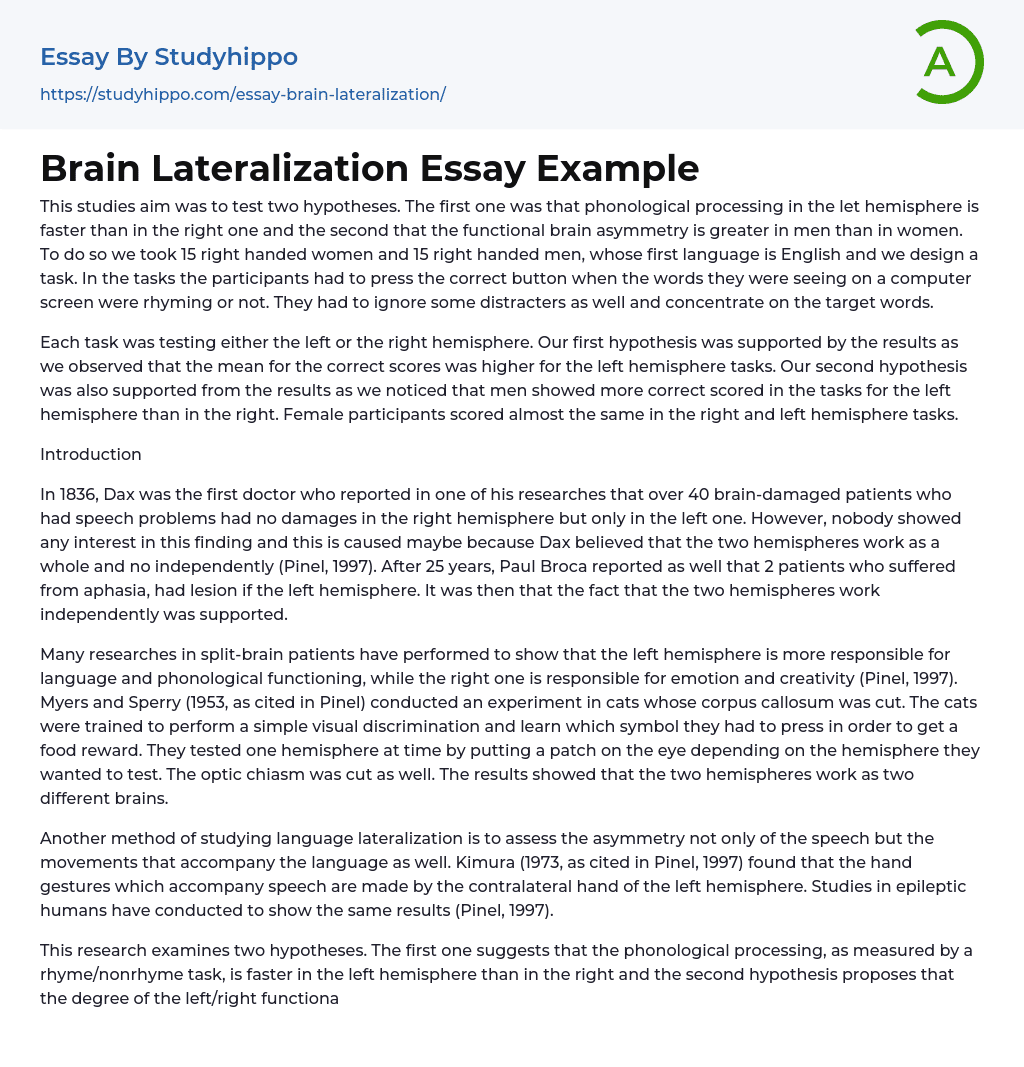This studies aim was to test two hypotheses. The first one was that phonological processing in the let hemisphere is faster than in the right one and the second that the functional brain asymmetry is greater in men than in women. To do so we took 15 right handed women and 15 right handed men, whose first language is English and we design a task. In the tasks the participants had to press the correct button when the words they were seeing on a computer screen were rhyming or not. They had to ignore some distracters as well and concentrate on the target words.
Each task was testing either the left or the right hemisphere. Our first hypothesis was supported by the results as we observed that the mean for the correct scores was higher for the left hemisphere tasks. Our second
...hypothesis was also supported from the results as we noticed that men showed more correct scored in the tasks for the left hemisphere than in the right. Female participants scored almost the same in the right and left hemisphere tasks.
Introduction
In 1836, Dax was the first doctor who reported in one of his researches that over 40 brain-damaged patients who had speech problems had no damages in the right hemisphere but only in the left one. However, nobody showed any interest in this finding and this is caused maybe because Dax believed that the two hemispheres work as a whole and no independently (Pinel, 1997). After 25 years, Paul Broca reported as well that 2 patients who suffered from aphasia, had lesion if the left hemisphere. It was then that the fact that the two
hemispheres work independently was supported.
Many researches in split-brain patients have performed to show that the left hemisphere is more responsible for language and phonological functioning, while the right one is responsible for emotion and creativity (Pinel, 1997). Myers and Sperry (1953, as cited in Pinel) conducted an experiment in cats whose corpus callosum was cut. The cats were trained to perform a simple visual discrimination and learn which symbol they had to press in order to get a food reward. They tested one hemisphere at time by putting a patch on the eye depending on the hemisphere they wanted to test. The optic chiasm was cut as well. The results showed that the two hemispheres work as two different brains.
Another method of studying language lateralization is to assess the asymmetry not only of the speech but the movements that accompany the language as well. Kimura (1973, as cited in Pinel, 1997) found that the hand gestures which accompany speech are made by the contralateral hand of the left hemisphere. Studies in epileptic humans have conducted to show the same results (Pinel, 1997).
This research examines two hypotheses. The first one suggests that the phonological processing, as measured by a rhyme/nonrhyme task, is faster in the left hemisphere than in the right and the second hypothesis proposes that the degree of the left/right functional cerebral asymmetry is more marked in men than in women.
Methodology
Participants: The participants of this study are 15 right handed women and 15 right handed men, whose first language is English.
Material: The experiment was based on the divided visual field paradigm and a phonological rhyme/nonrhyme task developed by Mead & Hampson (1996). Computer screens
were also used for the experiment.
Design: The study began with a set of 20 practice trials and after a brief rest period two blocks of 40 experimental trials followed. Each trial began after the press of a button with the appearance of a central fixation point (+), which lasted for 1 to 2 seconds. After these seconds the point was replaced by a cue word which lasted for 1 second. After a pause period of 40 ms, two word appeared on the screen one to each side of a central arrow, which either pointed to the left or right. The arrow always indicated the target word for 200ms and the other one was supposed to be ignored.
Procedure: At the beginning of the test the participants were asked their sex, if they were right handed and if their first language was English. Then they were instructed to look at the central point and keep their eyes at a distance of 30 cm of the computer screen, which ensures the presentation of the word only in one visual field and the contralateral hemisphere transmission. When the participants were feeling ready they had to press a button in order to start each of the trials. When the cue word and the target words appeared they had to decide whether or not they rhyme. If they rhymed they had to press the "K" key and if they didn't rhyme they had to press the "A" key.
- Central Nervous System essays
- Action Potential essays
- Blood essays
- Body essays
- Brain essays
- Childbirth essays
- Eye essays
- Glucose essays
- Heart essays
- Human Physiology essays
- Immune System essays
- Kidney essays
- Muscle essays
- Nervous System essays
- Neuron essays
- Poison essays
- Puberty essays
- Sense essays
- Skeleton essays
- Skin essays




